What's your escape?
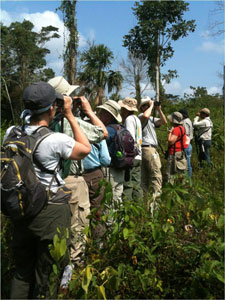
Every once in a while you have to do something that has nothing whatever to do with daily life and work, because if you don't, your brains lock up. For me, it's travel. Bird-watching travel. Particularly in the tropics.
So in February I took time off from spreadsheets and e-mail and deadlines and a Boston winter featuring one big snowstorm after another, and signed up with the Massachusetts Audubon Society for a birders' trip to Panama. There were seven of us—our tour leader, Sue McCallum, director of a group of Mass Audubon wildlife preserves; two couples and a friend from MIT who had created high-tech companies and sold them and now apparently devote themselves largely to bird-watching; Polly, a wildlife expert from Tennessee who was hoping she could manage being solely among Yankees for the better part of two weeks; and me.

Panamá Viejo
New bird and a historical canal
Panama City: a nice hotel, a good sleep, a morning of bird-watching in the ruins of stone towers and walls built in 1517 by conquistadores (mightily impressing the locals at the time who had never seen such tall buildings). In the underbrush, I saw my first GREAT new bird, the Barred Antshrike. You can't beat this robin-sized bird for stunning design and obvious strength of personality. Next we saw the Panama Canal and a big ship going through it. That was actually very interesting, especially since at night I was reading David McCullough's The Path Between the Seas: The Creation of the Panama Canal, 1870-1914 (history that reads like a novel).
Canopy Camp
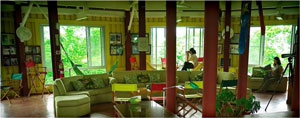
Elegant outdoor living
The next morning we got up at dawn, got into a white van, and drove for HOURS on a bumpy dusty road, which got progressively more difficult, until we were halfway to Columbia in the Darien jungle, hungry, tired, and grumbling. We arrived, feeling dubious, at the brand-new Canopy Camp in the jungle. The third group of guests ever. We found ourselves in an elegant outdoor lounge—library, bar, mahogany and leather, hammocks if the sofas didn't appeal—and no walls. It was the dry season and…
There. Are. No. Mosquitoes.
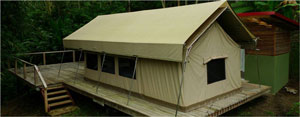
Karen's canopy tent
Our things were whisked away to tents while the wine was poured and dinner was prepared. We each had our own tent, with splendid beds, electricity (most of the time), mahogany floors, a deck from which to look right into the jungle, and an attached bath house. My shower had no roof, just stars, and the bathroom was supplied with frogs and cute little geckos for company.
Far and wide
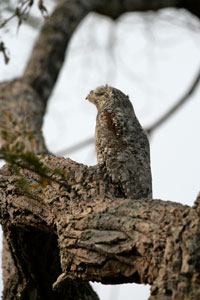
Great Potoo
mimicking a tree branch
The birders took two three- or four-hour hikes a day, and sometimes added a shorter trip at dawn or after dark. Sometimes we started on foot from camp. Sometimes we drove to a different environment—low swampy jungle; high dry mountainous forest; savannah lands with cattle. We went across the Continental Divide, the ridge of mountains that runs right through North America, Central America, down the middle of narrow little Panama, and all the way down South America as well. The little birds on the Caribbean side of the ridge are completely different from the little birds on the Pacific side. We crossed the ridge in a van, and yet they can't fly across? Who knew!
Birds and more
We looked at birds. We saw, if I remember correctly, 340 species of birds. Well, no, I personally saw 240 species of birds, because some I didn't find in my binoculars and some were seen by the others while I lounged in my tent and took a nap instead.
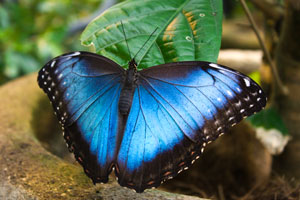
Blue Morpho Butterfly
The eeriest bird I saw was the Great Potoo. As big as a good-sized owl, nocturnal, and able to hide from eagles and hawks in broad daylight by turning into a piece of dead wood. [photo]. At night it hunts large moths and other flying insects with its big mouth. A favorite bird for beauty, IMHO—the female Blue Dacnis. Her mate is spectacular too: Luckily they always travel together.
My favorite insect was the blue morpho butterfly, as big as your hand, and almost tame, fluttering overhead. But, just try to catch one—forget it! Here' another favorite insect: industrious leaf-cutter ants, right in the middle of the path under my feet bringing home leaves on which they grow fungus gardens.

Tamandua napping in a tree
We saw a ton of little mammals, too. There was one I never met before, even in a zoo—the gold and brown tamandua, a charming, nonchalant, cat-sized anteater hunting for termites in fallen logs beside the road. I have seen on YouTube that some people have them for pets. I can see the appeal, but they belong where they came from, as they are highly specialized (with one huge claw on each paw) for tearing down termite nests. Leave them in that neotropical forest where they belong.
Then we went to Canopy Tower: that's a whole wonderful story for another day!
Scheming for next time
My trip had great company, great meals, and strenuous but always interesting hikes. When can I go again? How about Costa Rica next? Might see a Quetzal, or a harpy eagle! I'm saving up.



Post new comment